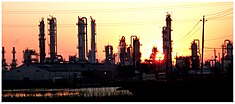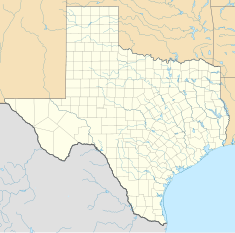Baytown Refinery
 From Wikipedia - Reading time: 11 min
From Wikipedia - Reading time: 11 min
 The Baytown Refinery | |
| Country | United States |
|---|---|
| City | Baytown, Texas |
| Coordinates | 29°44′20″N 95°00′38″W / 29.7390°N 95.0106°W |
| Refinery details | |
| Owner(s) | ExxonMobil |
| Commissioned | 1919 |
| Capacity | 588,000 bbl/d (93,500 m3/d) |
| Complexity index | 13.7 |
ExxonMobil's Baytown Refinery is a major oil refinery named after and located in Baytown, Texas. It has capacity of 588,000 barrels per day (93,500 m3/d).[1] The site first opened in 1919 and was originally operated by the Humble Oil Company. Today, it is the largest employer in the city. The plant has been expanded over the year to 3,400 acres (14 km2) of land next to the Houston Ship Channel.[2]
The Baytown Refinery is the fifth-largest refinery in the United States by production, after the nearby Port Arthur Refinery. Baytown is also ExxonMobil's third largest refinery, only trailing Exxon's Beaumont Refinery and Jurong Island refinery in Singapore.
Units
[edit]According to ExxonMobil's filings with the US DOE's Energy Information Agency, the unit capacities for the Baytown Refinery are presented below:[3]
| Units | Capacity in BPCD |
|---|---|
| Total Refinery Nameplate | 588,000 |
| Atmospheric Distillation | 588,000 |
| Vacuum Distillation | 297,000 |
| Delayed Coking | 54,000 |
| Fluid Coking | 42,000 |
| FCC | 220,000 |
| Hydrocracking | 30,600 |
| Fuels Deasphalting (SDA) | 47,000 |
| Naphtha Reforming | 126,500 |
| Aklylation | 44,500 |
| ULSD Hydrotreating | 158,300 |
| Gasoline/Naphtha Hydrotreating | 203,800 |
| Kero Jet Hydrotreating | 132,700 |
| Naphtha Reformer Feed Hydrotreating | 157,000 |
| Heavy Gas Oil Hydrotreating | 117,000 |
| Lubricants | 32,000 |
The refinery has a Nelson Complexity Index of 13.7, making it highly complex.[4]
ExxonMobil is developing a large blue hydrogen facility at Baytown to support the refinery and sequester CO2. The project is expected to capture and store 7 million mt of CO2 per year.[5] The Abu Dhabi National Oil Company (ADNOC) purchased a 35% stake of this project in 2024.[5]
The refinery site is also home to extensive petrochemical production including multi-train olefins production. The olefins plans are proposed to become users of blue hydrogen from the mega project being developed with ADNOC that will lower the petrochemical site's emissions by capturing 98% of the CO2 produced at the facility.[6]
The refinery site has two electricity generating power plants.[7][8]
| Unit Name | Status | Fuel(s) | Capacity (MW) | Type | Combined Heat & Power | Year |
|---|---|---|---|---|---|---|
| Gen 4 | Operating | Natural Gas | 99 | Gas Turbine | Yes | 1997 |
| Gen 5 | Operating | Natural Gas | 164 | Gas Turbine | Yes | 2004 |
The site has 3 worldscale ethylene cracking plants with the newest being commissioned in 2018 with 1.5 million tons per year of capacity and being fed with purity ethane.[9]
Total ethylene cracking capacity for the site is currently 3.6 million tons per year[10] and is presented in the table below by unit as presented in the Oil & Gas Journal Survey of Steam Crackers. [11]
| Steam Cracker(s) | Capacity in Mtpa | Feed 1 | Feed 2 |
|---|---|---|---|
| 3 | 1.5 | Ethane | |
| 1 & 2 | 2.2 | Ethane | LPG |
The refinery has several polymerization units that consume the olefins generated on site.[12]
Greenhouse gas emissions history
[edit]As a major emitting facility, The ExxonMobil Baytown Refinery and Petrochemical Site must report its complete greenhouse gas emissions to the EPA every year subject to the EPA's Greenhouse Gas Reporting Program. The Baytown site's Facility ID is 1007542 and its FRS ID is 110000463178. [13]
Statutory reporting data is in the table below:
| Year | Total Reported
Direct Emissions |
CO2 Emissions
Non-Biogenic |
Methane
Emissions |
Nitrous Oxide
Emissions |
|---|---|---|---|---|
| metric ton | metric ton | metric ton | metric ton | |
| 2023 | 12,693,547 | 12,621,516 | 39,860 | 32,171 |
All emissions data is presented in units of metric tons of carbon dioxide equivalent using GWP's from IPCC's AR4
According the EPA's database for 2022, the Baytown (combined site) ranked as the 6th largest GhG emitter in the United States for 2023 with 12.6 million tons of emissions. [14]
Operating permits
[edit]The refinery is a major facility that operates under the Clean Air and Clean Water Acts, in addition to RCRA and other statutes. The sites FRS ID is 110000502901.[15]
Major permits are detailed in the chart below and can be found on the EPA's website here[16] and at the state level.[17]
| Program | ID Type | ID Number | ID Status |
| AIR OPERATING PERMITS | PERMIT | 4614 | CANCELLED |
| AIR OPERATING PERMITS | PERMIT | 1229 | PENDING |
Labor relations
[edit]The Baytown site is a union facility with the United Steelworkers Local 13-2001 representing operations, instrument, lab and mechanical employees. The membership is approximately 600.[18] In addition to the USW, three other unions represent workers at the site including:
- International Association of Machinists and Aerospace Workers
- Machinists, Lodge 1051 with 86 members[19]
- International Brotherhood of Electrical Workers
Labor history
[edit]Labor relations have, at times, been contentious at the Baytown refinery. A long-standing dispute at the Beaumont Refinery, led to accusations of ExxonMobil attempting to decertify the USW at the site.[20]
Operating history and accidents
[edit]On December 23, 2021, a large explosion occurred at the refinery in what was described as a major industrial accident by both local and national news.[21][22] The explosion, caused by a fire, occurred around 1AM and seriously injured five workers, four of whom were airlifted to the hospital with one being transported by ambulance. No fatalities were reported.[23] Two of the injured contract workers have filed a $10 million lawsuit against ExxonMobil and partner Team Industrial Services for unsafe working conditions as of a result of the explosion.[21]
A July 31, 2019 fire in a polymerization unit occurred when a popcorn polymer built up in a line and ruptured, causing a fireball reaching 900 feet into the air. After a 3 week jury trial, a verdict of responsibility was won for the plaintiffs resulting in $28.5 million in damages for compensation for 5 injured workers.[24]
Despite the accidents, the Baytown Refinery is regarded to be a well-run refinery that has won several awards in process and personal safety. The chemical and olefins units at the refinery each won the AFPM Elite Gold Safety Award in 2023.[25]
The refinery's Operations team set a record for OHSA performance regarding safety of 18 years without a recordable injury according to a 2024 press release from the SEA Conference:
With an impressive record of over 18 years and 11.2 million work hours without an OSHA-recordable injury, our Baytown team sets the industry standard in safety and operational excellence.[26]
See also
[edit]- Atmospheric Distillation
- HF Acid Alkylation
- Cracking
- Delayed Coking
- Naphtha Reforming
- Hydrotreating
- Fluid Coking
- Solvent Deasphalting of Crude Oil
References
[edit]- ^ "Baytown Complex - Company Profile 2023" (PDF). ExxonMobil. 2 April 2024. Retrieved 2 April 2024.
- ^ "ExxonMobil announces $2 billion Baytown chemical expansion project; releases study showing value of investments to U.S. economy". ExxonMobil. Retrieved 2024-11-08.
- ^ "Data & Statistics". www.afpm.org. Retrieved 2024-10-24.
- ^ "Refinery profile: Baytown coking refinery, the US". Offshore Technology. 2021-10-27. Retrieved 2024-11-11.
- ^ a b gasworld (2024-09-05). "ADNOC to acquire 35% stake in ExxonMobil's Baytown hydrogen project". gasworld. Retrieved 2024-10-31.
- ^ Vasquez, Lucio (2024-03-25). "Baytown plant with troubled track record could receive up to $332 million from federal government to lower emissions". Houston Public Media. Retrieved 2024-10-31.
- ^ "ExxonMobil Baytown power station". Global Energy Monitor. Retrieved 2024-11-08.
- ^ "Form EIA-860 detailed data". U.S. Energy Information Agency. 2022.
- ^ "ExxonMobil starts up new ethane cracker in Baytown Texas". ExxonMobil. Retrieved 2024-11-08.
- ^ Hays, Kristen (2019). "Steam cracker at ExxonMobil's Texas chemical complex shuts after PRU fire: sources". S&P Global.
- ^ Koottungal, Leena (2015-07-07). "International survey of ethylene from steam crackers - 2015". Oil & Gas Journal. Retrieved 2024-11-08.
- ^ "ExxonMobil expands chemical production at Baytown". ExxonMobil. Retrieved 2024-11-11.
- ^ US EPA, OAR (2015-05-18). "Data Sets". www.epa.gov. Retrieved 2024-11-01.
- ^ Fagelson, Nathaniel (2024). "Top 10 greenhouse gas polluters in Texas". Environment Texas - Research and Policy Center.
- ^ "Detailed Facility Report | ECHO | US EPA". echo.epa.gov. Retrieved 2024-11-11.
- ^ "FRS Facility Detail Report - Baytown Refinery". United States Environmental Protection Agency. 2024.
- ^ Quality, Texas Commission on Environmental. "TCEQ CR Query". Texas Commission on Environmental Quality. Retrieved 2024-11-11.
- ^ "United Steelworkers Local 13-2001". USW Local 13-2001.
- ^ "Union FactsUnion Facts". Union Facts. Retrieved 2024-11-07.
- ^ Seba, Erwin (2021). "Exxon, union try new approach to resolve increasingly bitter dispute". Reuters.
- ^ a b Vasquez, Lucio (2021-12-27). "2 injured workers file $10 million lawsuit against ExxonMobil after Baytown refinery explosion". Houston Public Media. Retrieved 2022-01-27.
- ^ ""Major industrial accident" sets off fire at ExxonMobil refinery". www.cbsnews.com. 23 December 2021. Retrieved 2022-01-27.
- ^ "ExxonMobil Baytown explosion: 4 workers hurt in 'major industrial accident'". FOX TV Digital Team. 2021-12-23. Retrieved 2022-01-27.
- ^ Taylor, Brittany (2023-02-21). "ExxonMobil to pay over $28 million to 5 workers injured in 2019 plant explosion, law firm says". KPRC. Retrieved 2024-11-11.
- ^ "AFPM Safety Awards". afpm.org. Retrieved 2025-03-24.
- ^ "Our Baytown Operations team awarded Gold award by ExxonMobil". Kent. Retrieved 2025-03-24.
External links
[edit]
 KSF
KSF

